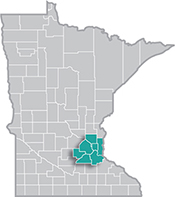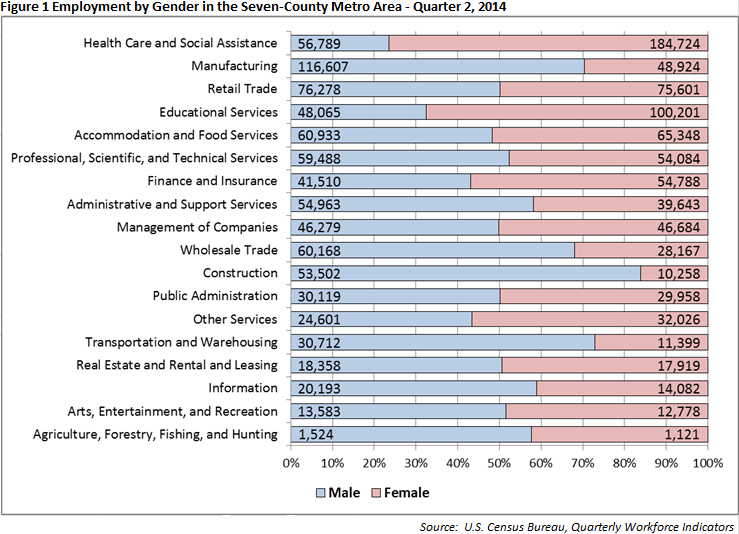 The Minneapolis-St. Paul metropolitan area is a national leader in finance, advanced manufacturing, agriculture and retailing.
The Minneapolis-St. Paul metropolitan area is a national leader in finance, advanced manufacturing, agriculture and retailing.
Medical devices, electronics and processed foods are strong suits recognized globally.
Want the freshest data delivered by email? Subscribe to our regional newsletters.
3/10/2015 2:23:55 PM
Tim O'Neill
According to the U.S. Census Bureau's Quarterly Workforce Indicators (QWI) tool, the percentage of female workers in the Seven-County Metro Area (50.4 percent) is nearly identical to the percentage of male workers (49.6 percent).
When analyzing the various industry sectors, however, it becomes apparent that the gender distributions are not so balanced.
Female workers dominate some industries, such as healthcare and social assistance and educational services, while men dominate others, such as construction and manufacturing (see Figure 1).

With charts, maps, and interactive data, DEED's QWI tool allows users to gather and study industry employment data by age, gender, educational attainment, race, and ethnicity in specific geographies and over certain time periods. Users can further subdivide information by job creations, turnover, earnings, and a host of other indicators. This tool is a part of the Longitudinal Employer-Household Dynamics (LEHD) program at the U.S. Census Bureau, which is becoming increasingly useful in helping state and local governments, agencies, and businesses make better-informed decisions in their local areas.
Using this tool, for example, one can learn that healthcare and social assistance is the largest-employing industry in the Twin Cities Metro area. In fact, over one in seven workers in the area have jobs in this industry. Adding data by gender enriches the analysis - showing that women hold 77 percent of healthcare jobs. Other industry sectors dominated by female workers include:
Alternatively, men hold 84 percent of the 63,760 estimated construction jobs in the Twin Cities metro. Other industry sectors dominated by males include:
Studying industry employment is a great way to determine a local economy's most distinguishing sectors, and to identify its growing or declining areas. Including demographic data allows for increased insight. Beyond the QWI tool, the U.S. Census Bureau's American Community Survey and U.S. Bureau of Labor Statistic's Current Population Survey are great resources for finding employment information broken down by industry, occupation, age, gender, race, educational attainment, and more. Our next two metro blogs will use these resources to analyze occupational data by gender and pay differences.
Contact Tim O'Neill at 651-259-7401.